Flying at 125 MPH to Keep Up With “F1” Cars: Aerial Cinematographer Phil Arntz on the Abu Dhabi Grand Prix Sequence
It was especially fun for aerial cinematographer Phil Arntz to return to Abu Dhabi with his camera pilot, Will Banks, for the climactic racing sequence in Joseph Kosinski’s pedal-to-the-metal epic F1. “I used to live in Dubai around 2012 or 2013, when I did a lot of filming for extreme sports. So, it was nice coming back because many of the crew, like the Shotover technician and the team with the helicopter, are all people I’ve known for years,” he recalls.
The racing actioner starring Brad Pitt as racing veteran Sonny Hayes and Damson Idris as the hot-shot rookie Joshua Pearce has just crossed the $500 million mark globally. In our previous conversation with Arntz, he talked about shooting at the Silverstone track in the United Kingdom. Today, we focus on the climactic race set and filmed at the Abu Dhabi Grand Prix. This presented its own set of challenges (temperature and maximum altitude) but also gave audiences a singular look with the famed Yas Marina Circuit.
You and Will also worked on another massive action film that came out this summer, Mission: Impossible – The Final Reckoning, two very kinetic but different films.
Both utilized aerial filming to create that sense of speed. But F1 is more considered in the story beats with more precise setups, whereas Mission: Impossible -The Final Reckoning was an exploration of shooting an aerial sequence, because no one’s really done it before. We were trying to figure out what to do with the aircraft and how to capture it. Both were challenging in their own regard.
Since F1 was filmed throughout the 2023 and 2024 World Championships, between testing, prep, and shooting, how long were you on this project?
Most of the time, we come in as needed to shoot the aerial work and disappear until the call comes again to pick up bits and pieces. Silverstone was really early on in the filming. We did some other stuff in Oxfordshire with Brad driving cars around the countryside, which was quite lovely. Abu Dhabi was much later in the year – that’s the final race in the calendar.
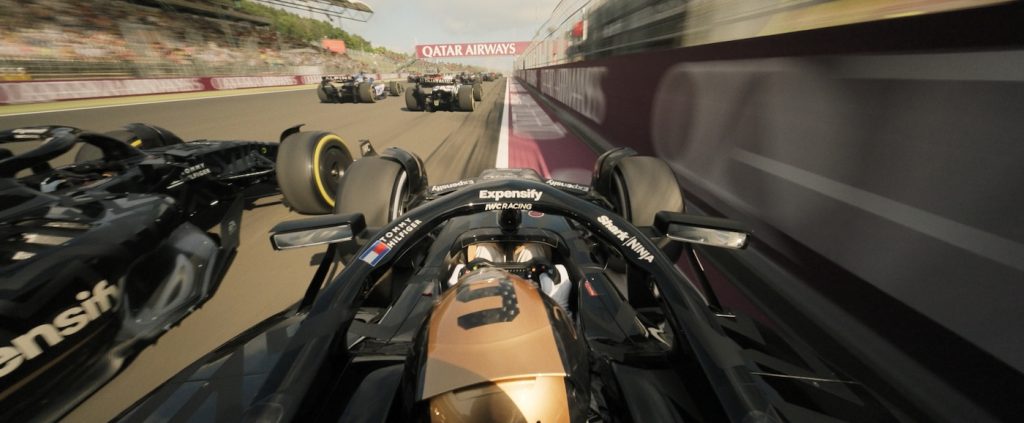
How did you prepare for the Abu Dhabi race?
The first challenge with Abu Dhabi is the temperature. The hotter it gets, the less an aircraft wants to fly with a lot of power. The heli we normally used is quite heavy, so for Will, a lot of thought went into managing the energy because we still wanted to get down to track level, right through the grandstands towards the control tower at a really low level.
Compared to the other sequences in the film, how was this different?
It was at night and right under the approach to Abu Dhabi International Airport. So, you can’t go any higher than 200 feet. Most permits restrict anything lower than 200 feet. So, it was just track-level to 200 feet. It was about finding really dynamic angles of the cars going around the circuit. I did about a week’s worth of prep from London, drawing up diagrams of what I figured might be nice shots. What was really handy is that the Yas Marina Circuit in Abu Dhabi is on Google Street View, an amazing scouting tool where you could look at angles ahead of time and see what works really well.
What was it like to shoot at the Yas Marina track?
We would go low as the car crests over the hill, and you’re countering them. A lot of it was about creating a sense of speed from a moving camera at a low angle. We had to find the angles that you can’t normally get in a live broadcast because their helicopter covers it in a Top Shot. Whereas we were flying really low, countering the cars, flying low over them, and chasing them from behind. Those cars are so bloody quick, even if you’re going full chat on a helicopter, keeping up with them isn’t possible. It was about working out the timing of how to get to them in the right moments, like cutting corners to come low behind the cars.
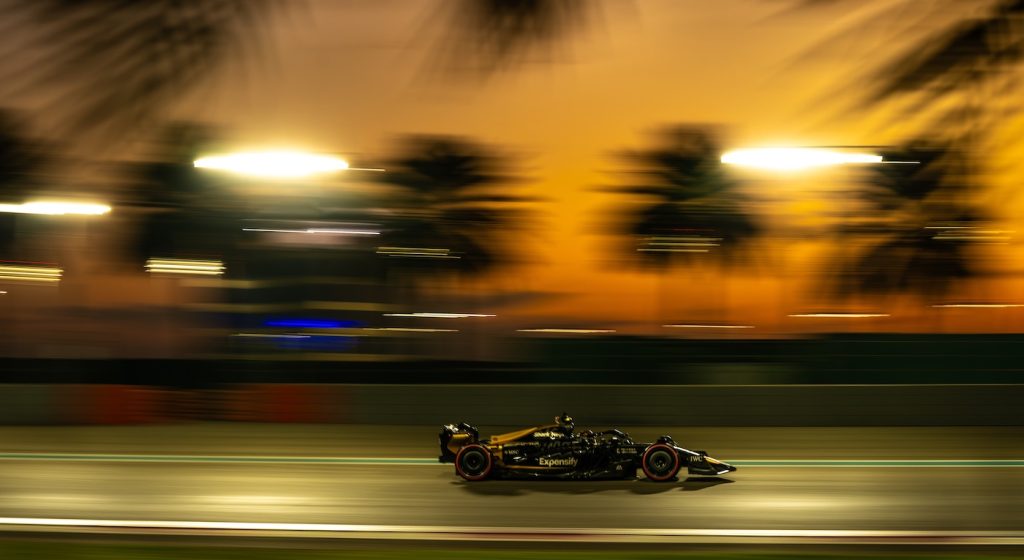
For the Silverstone sequence in the U.K., you talked about adhering to the Civil Aviation Authority’s requirements. What was the equivalent process in Abu Dhabi?
Abu Dhabi was great because we had permission to fly the entire track at a very low level, so we had more time to figure things out. We flew it without cars for about an hour to look at some angles, but also for Will to make sure that he knew where the obstacles were, like wires, light poles, and gantries. And you’ve got the W Hotel in the middle of the track.
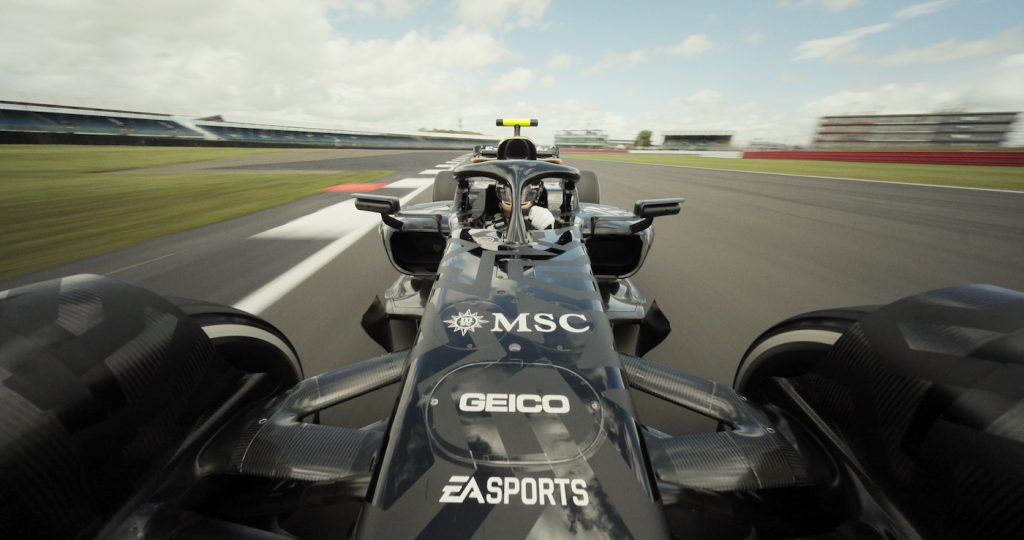
It’s pretty insane that it was challenging for the helicopter going at top speed to keep up with the cars blazing at 200 mph!
The helicopter we had in Abu Dhabi probably maxed out at about 125-130 mph. The cars were probably going 200 mph. So, there’s a deficit of 70-80 mph. A car takes time to accelerate from a corner, but our acceleration is nowhere near that of a race car. So, we had to judge the distances so that we were right behind these cars at a low level as they went under this gantry, and it took one or two runs to work out the timing. But it was a fun challenge to keep up with vehicles that were honestly pedal to the metal.
Did you also use the Airbus AS355?
Yes, but the difference was we owned the one in the U.K., so we could strip everything out of it to make it as light as possible. It doesn’t have air conditioning, floats, a headliner, or all the interior that makes it look nice. But we don’t own the one in Abu Dhabi, which had everything intact and probably weighs 300kgs more than ours. You really feel that, especially when you’re flying in 35 degrees Celsius [95 Fahrenheit].
The Yas Marina Circuit has a very distinct look, but compared to other locations, it has not been featured on film as often. I think it was in Furious 7.
The Yas Marina track is an amazing location! It’s by a river and has a lot of cool architecture. One day, there was a massive super yacht right next to the track. So, we tried to showcase the elements that you can only get in Abu Dhabi. We went exploring for cool shots all around the circuit.
Was any drone photography involved?
We didn’t use drones on the work we did, but I think there were some days when drones were used. Drones are limited to distance and speed, and you really need a full-size manned aircraft to keep up with these cars.
What was the choreography design like with Joe and Claudio [Miranda, cinematographer]?
Some of the stuff was heavily Previs’d. For Abu Dhabi, I created a 30-page PDF with some ideas. After we shot them, we’d get feedback from the ground from Joe and Claudio. There were certain story beats where one car overtakes the other in this part of the track that we had to capture in counter moves. Once the drivers decide where the overtake will occur, they have a marker on the track, say at a gantry. We had to counter it at 100 miles an hour from the opposite direction. There’s a lot of timing involved to start your flight a mile in the opposite direction, go full chat, and then meet them right in the middle where the move happens. The only timing cue was the marker on the track. It was really challenging to get that dialed in perfectly.
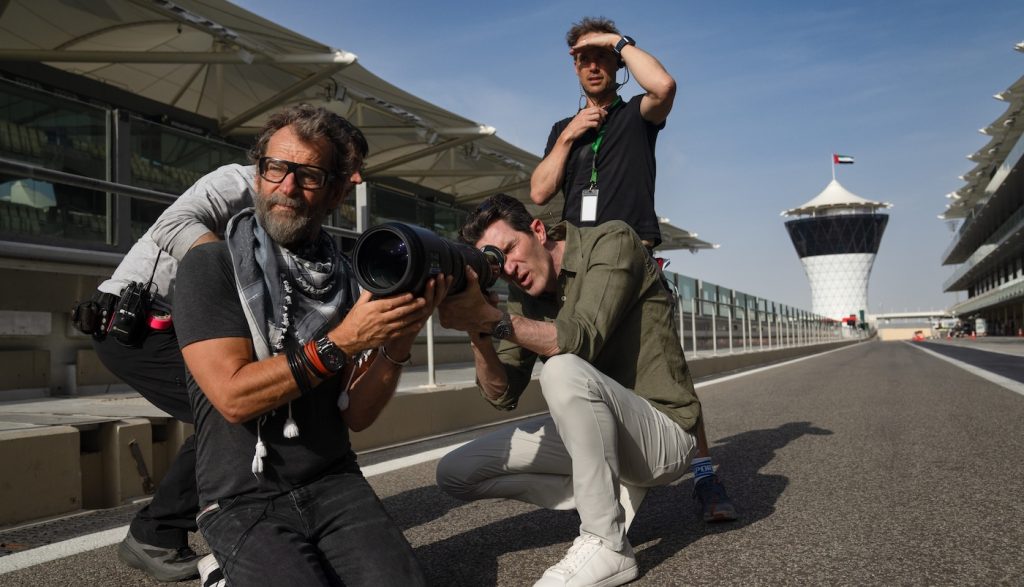
Were you communicating with Joe and Claudio in real-time during all these flights?
Joe had control of the cameras [mounted on the cars] with live video feed in the garage [referring to the video village]. There was an RF [radio frequency wireless] team that handled all the wireless video system, regardless of where you were and what altitude, there was always a picture in the garage. We could be at track level a mile and a half away, and they would get a perfect image. The wireless video team had the entire track set up to receive live video, which was really impressive. Wireless video downlinks can sometimes be difficult, and you don’t get a picture all the time. It was absolutely mind-blowing how they created this perfect HD video signal all around the track.
Was this only at Silverstone?
This was at every race, live around the entire track. When we came in, all they had to do was dial us into the frequency, and we could make use of their on-the-ground video system so they could receive our picture wherever we were. That was really impressive. The main reason wasn’t for us. They had these little cameras on the race cars, and Joe was directing from the garage. So, he was cueing the camera moves. To do that, you need perfect video and camera control the entire way. It was nice that we could piggyback on that.
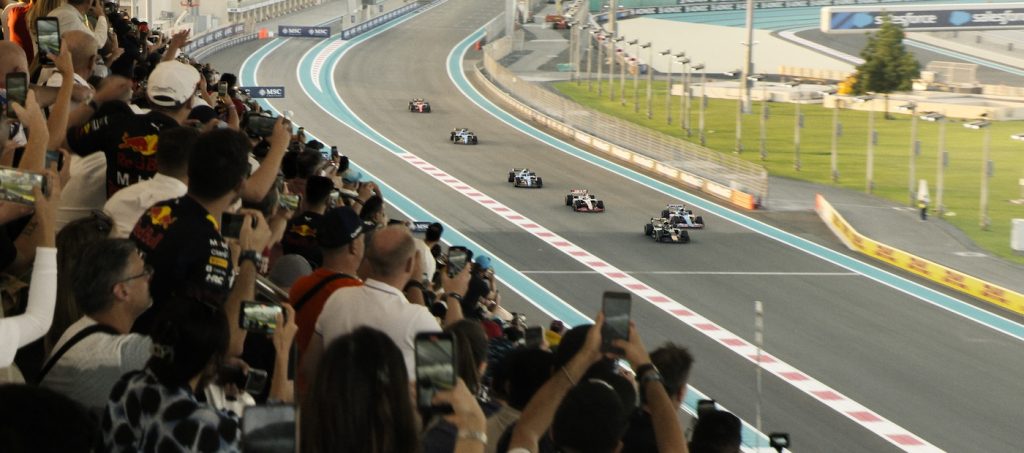
F1 is playing in theaters nationwide.
Featured image: Brad Pitt in “F1.” Courtesy Warner Bros.

